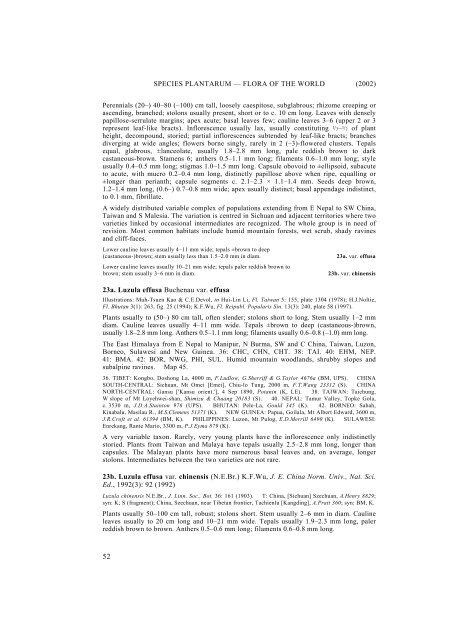Part 6. JUNCACEAE 1: Rostkovia to Luzula - Species Plantarum ...
Part 6. JUNCACEAE 1: Rostkovia to Luzula - Species Plantarum ...
Part 6. JUNCACEAE 1: Rostkovia to Luzula - Species Plantarum ...
You also want an ePaper? Increase the reach of your titles
YUMPU automatically turns print PDFs into web optimized ePapers that Google loves.
52<br />
SPECIES PLANTARUM — FLORA OF THE WORLD (2002)<br />
Perennials (20–) 40–80 (–100) cm tall, loosely caespi<strong>to</strong>se, subglabrous; rhizome creeping or<br />
ascending, branched; s<strong>to</strong>lons usually present, short or <strong>to</strong> c. 10 cm long. Leaves with densely<br />
papillose-serrulate margins; apex acute; basal leaves few; cauline leaves 3–6 (upper 2 or 3<br />
represent leaf-like bracts). Inflorescence usually lax, usually constituting 1/3– 1/2 of plant<br />
height, decompound, s<strong>to</strong>ried; partial inflorescences subtended by leaf-like bracts; branches<br />
diverging at wide angles; flowers borne singly, rarely in 2 (–3)-flowered clusters. Tepals<br />
equal, glabrous, ±lanceolate, usually 1.8–2.8 mm long, pale reddish brown <strong>to</strong> dark<br />
castaneous-brown. Stamens 6; anthers 0.5–1.1 mm long; filaments 0.6–1.0 mm long; style<br />
usually 0.4–0.5 mm long; stigmas 1.0–1.5 mm long. Capsule obovoid <strong>to</strong> ±ellipsoid, subacute<br />
<strong>to</strong> acute, with mucro 0.2–0.4 mm long, distinctly papillose above when ripe, equalling or<br />
±longer than perianth; capsule segments c. 2.1–2.3 × 1.1–1.4 mm. Seeds deep brown,<br />
1.2–1.4 mm long, (0.6–) 0.7–0.8 mm wide; apex usually distinct; basal appendage indistinct,<br />
<strong>to</strong> 0.1 mm, fibrillate.<br />
A widely distributed variable complex of populations extending from E Nepal <strong>to</strong> SW China,<br />
Taiwan and S Malesia. The variation is centred in Sichuan and adjacent terri<strong>to</strong>ries where two<br />
varieties linked by occasional intermediates are recognized. The whole group is in need of<br />
revision. Most common habitats include humid mountain forests, wet scrub, shady ravines<br />
and cliff-faces.<br />
Lower cauline leaves usually 4–11 mm wide; tepals ±brown <strong>to</strong> deep<br />
(castaneous-)brown; stem usually less than 1.5–2.0 mm in diam. 23a. var. effusa<br />
Lower cauline leaves usually 10–21 mm wide; tepals paler reddish brown <strong>to</strong><br />
brown; stem usually 3–6 mm in diam. 23b. var. chinensis<br />
23a. <strong>Luzula</strong> effusa Buchenau var. effusa<br />
Illustrations: Muh-Tsuen Kao & C.E.Devol, in Hui-Lin Li, Fl. Taiwan 5: 155, plate 1304 (1978); H.J.Noltie,<br />
Fl. Bhutan 3(1): 263, fig. 25 (1994); K.F.Wu, Fl. Reipubl. Popularis Sin. 13(3): 240, plate 58 (1997).<br />
Plants usually <strong>to</strong> (50–) 80 cm tall, often slender; s<strong>to</strong>lons short <strong>to</strong> long. Stem usually 1–2 mm<br />
diam. Cauline leaves usually 4–11 mm wide. Tepals ±brown <strong>to</strong> deep (castaneous-)brown,<br />
usually 1.8–2.8 mm long. Anthers 0.5–1.1 mm long; filaments usually 0.6–0.8 (–1.0) mm long.<br />
The East Himalaya from E Nepal <strong>to</strong> Manipur, N Burma, SW and C China, Taiwan, Luzon,<br />
Borneo, Sulawesi and New Guinea. 36: CHC, CHN, CHT. 38: TAI. 40: EHM, NEP.<br />
41: BMA. 42: BOR, NWG, PHI, SUL. Humid mountain woodlands, shrubby slopes and<br />
subalpine ravines. Map 45.<br />
3<strong>6.</strong> TIBET: Kongbo, Doshong La, 4000 m, F.Ludlow, G.Sherriff & G.Taylor 4676a (BM, UPS). CHINA<br />
SOUTH-CENTRAL: Sichuan, Mt Omei [Emei], Chiu-lo Tung, 2000 m, F.T.Wang 23312 (S). CHINA<br />
NORTH-CENTRAL: Gansu ['Kansu orient.'], 4 Sep 1890, Potanin (K, LE). 38. TAIWAN: Taichung,<br />
W slope of Mt Loyehwei-shan, Shimizu & Chuang 20183 (S). 40. NEPAL: Tamur Valley, Topke Gola,<br />
c. 3530 m, J.D.A.Stain<strong>to</strong>n 976 (UPS). BHUTAN: Pele-La, Gould 345 (K). 42. BORNEO: Sabah,<br />
Kinabalu, Masilau R., M.S.Clemens 51371 (K). NEW GUINEA: Papua, Goilala, Mt Albert Edward, 3600 m,<br />
J.R.Croft et al. 61394 (BM, K). PHILIPPINES: Luzon, Mt Pulog, E.D.Merrill 6490 (K). SULAWESI:<br />
Enrekang, Rante Mario, 3300 m, P.J.Eyma 879 (K).<br />
A very variable taxon. Rarely, very young plants have the inflorescence only indistinctly<br />
s<strong>to</strong>ried. Plants from Taiwan and Malaya have tepals usually 2.5–2.8 mm long, longer than<br />
capsules. The Malayan plants have more numerous basal leaves and, on average, longer<br />
s<strong>to</strong>lons. Intermediates between the two varieties are not rare.<br />
23b. <strong>Luzula</strong> effusa var. chinensis (N.E.Br.) K.F.Wu, J. E. China Norm. Univ., Nat. Sci.<br />
Ed., 1992(3): 92 (1992)<br />
<strong>Luzula</strong> chinensis N.E.Br., J. Linn. Soc., Bot. 36: 161 (1903). T: China, [Sichuan] Szechuan, A.Henry 8829;<br />
syn: K; S (fragment); China, Szechuan, near Tibetan frontier, Tachienlu [Kangding], A.Pratt 360; syn: BM, K.<br />
Plants usually 50–100 cm tall, robust; s<strong>to</strong>lons short. Stem usually 2–6 mm in diam. Cauline<br />
leaves usually <strong>to</strong> 20 cm long and 10–21 mm wide. Tepals usually 1.9–2.3 mm long, paler<br />
reddish brown <strong>to</strong> brown. Anthers 0.5–0.6 mm long; filaments 0.6–0.8 mm long.












